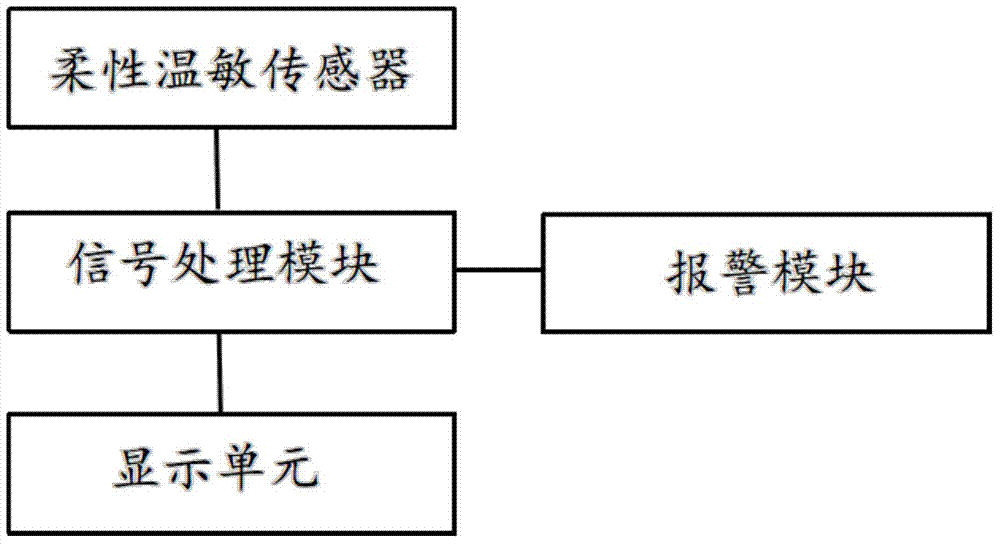Flexible temperature-sensitive sensor and body temperature monitoring system based on same
A temperature-sensitive sensor and monitoring system technology, which is applied in sensors, diagnostic recording/measurement, medical science, etc., can solve the problems of inconvenient operation and the inability of the body temperature monitoring system to continuously record body temperature changes, so as to achieve easy portability and remote medical monitoring. , the effect of improving the conversion efficiency
- Summary
- Abstract
- Description
- Claims
- Application Information
AI Technical Summary
Problems solved by technology
Method used
Image
Examples
Embodiment 1
[0041] Example 1: Please refer to figure 1 , the present invention provides a flexible temperature-sensitive sensor, comprising: a flexible substrate 4, a temperature-sensitive material layer 3, an electrode layer 2 and a flexible protective layer 1, the temperature-sensitive material layer 3 is formed on the surface of the flexible substrate 4 and has Three-dimensional porous nanostructure, the electrode layer 2 includes two electrodes, the electrodes are drawn from the surface of the temperature-sensitive material layer 3, the flexible protective layer 1 is formed on the surface of the temperature-sensitive material layer 3 and the electrode layer 2 is located on the surface of the temperature-sensitive material layer Part of layer 3 surface.
[0042] Wherein, the temperature-sensitive material layer is prepared by the following steps:
[0043] S1. After mixing 2g of reduced graphene oxide and 2g of ethanol, ultrasonic treatment was performed for 30 minutes to obtain a slur...
Embodiment 2
[0075] See figure 1 , the present invention provides a flexible temperature-sensitive sensor for body temperature monitoring, comprising: a flexible substrate 4, a temperature-sensitive material layer 3, an electrode layer 2 and a flexible protective layer 1, the temperature-sensitive material layer 3 is formed on the flexible substrate The surface of the bottom 4 has a three-dimensional porous nanostructure, the electrode layer 2 includes four electrodes, and the electrodes are drawn from the temperature-sensitive material layer 3 , and the flexible protective layer 1 is formed on the surface of the temperature-sensitive material layer 3 .
[0076] Wherein, the temperature-sensitive material layer is prepared by the following steps:
[0077] S1. After mixing 2 g of reduced graphene oxide and 3 g of ethanol, ultrasonic treatment was performed for 40 min to obtain a slurry mixture;
[0078] S2, add 2g to the slurry mixture, the density is 1.043g / cm 3 PDMS, a viscous mixture w...
Embodiment 3
[0111] See figure 1 , the present invention provides a flexible temperature-sensitive sensor, comprising: a flexible substrate 4, a temperature-sensitive material layer 3, an electrode layer 2 and a flexible protective layer 1, the temperature-sensitive material layer 3 is formed on the surface of the flexible substrate 4 and has Three-dimensional porous nanostructure, the electrode layer 2 includes two electrodes, the electrodes are drawn from the surface of the temperature-sensitive material layer 3, the flexible protective layer 1 is formed on the surface of the temperature-sensitive material layer 3 and the electrode layer 2 is located on the surface of the temperature-sensitive material layer Part of layer 3 surface.
[0112] Wherein, the temperature-sensitive material layer is prepared by the following steps:
[0113] S1, after mixing 5g graphene and 15g dichloromethane, perform ultrasonic treatment for 50min to obtain a slurry mixture;
[0114] S2, add 1g to the slurr...
PUM
| Property | Measurement | Unit |
|---|---|---|
| Thickness | aaaaa | aaaaa |
| Thickness | aaaaa | aaaaa |
| Thickness | aaaaa | aaaaa |
Abstract
Description
Claims
Application Information
 Login to View More
Login to View More - R&D
- Intellectual Property
- Life Sciences
- Materials
- Tech Scout
- Unparalleled Data Quality
- Higher Quality Content
- 60% Fewer Hallucinations
Browse by: Latest US Patents, China's latest patents, Technical Efficacy Thesaurus, Application Domain, Technology Topic, Popular Technical Reports.
© 2025 PatSnap. All rights reserved.Legal|Privacy policy|Modern Slavery Act Transparency Statement|Sitemap|About US| Contact US: help@patsnap.com


